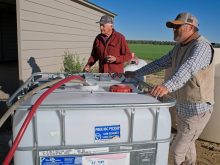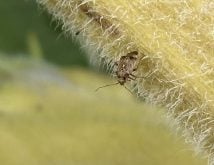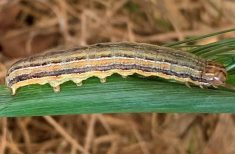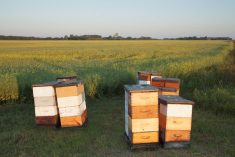For farmers who live in areas of the Prairies that received above-average snowfall this past winter, one entomologist is cautioning them not to get lulled into a false sense of security about the threat posed by insects this growing season.
“I’ve been cautioning people not to assume that there’s going to be any increased mortality of things like grasshoppers and flea beetles because of all the snow and the weather conditions,” says John Gavloski, an entomologist based in Carman, Man., with Manitoba Agriculture.
“Sometimes people like to make the assumption that (because) there is a lot of moisture in the ditches in April and May … it will kill the grasshoppers. That’s not necessarily true. Grasshoppers overwinter as eggs and those eggs have an outer shell that is very resistant to that excess moisture. It is right after these eggs hatch, which is generally late May through early June, that grasshoppers become more susceptible to excess rainfall,” he adds.
Read Also

Claas brings 1000 Series SP forage harvesters to Canada
In mid-August, Claas unveiled its new line of Jaguar forage harvesters at an event in Visalia, California, deep in the heart of that state’s dairy region.
Grainews recently spoke with experts across the West about the insect forecast for 2022 and what farmers should prepare for.
Manitoba
Flea beetles and grasshoppers were the two biggest insect concerns in Manitoba in 2021. Gavloski advises farmers to keep these crop pests as monitoring priorities again in 2022, despite moister soil, which should allow most plants to get off to a better start than they did during last spring’s extremely dry conditions. While flea beetles are largely a problem in canola crops, Gavloski says grasshoppers will be a threat to most major crops. Conditions that enable canola to have quick germination and growth through the seedling stage will reduce the risk of excessive damage by flea beetles.

Lygus bugs were another concern in Manitoba and could be a problem this year, according to Gavloski. Part of the challenge with lygus bugs is they have a wide variety of plant hosts including alfalfa, canola, dry beans, strawberries and sunflowers.
The alfalfa weevil is an early-season pest that farmers in Manitoba will want to keep an eye on. Last year it was a problem in localized areas, mainly in eastern portions of the province and the Interlake region. It could pose a problem for alfalfa and other legume growers again this year, especially in the east and Interlake regions.
Gavloski says it’s difficult to predict what kind of presence insects that don’t overwinter in Manitoba could have in the province this season. That includes diamondback moths, aphids in cereal crops and soybean aphids. There were localized problems with diamondback moths and aphids in cereals in 2021, and while soybean aphids haven’t been a problem in some time, they do remain a risk, he adds.

Gavloski’s advice to growers on how best to manage the insect pest threats on their farms is to conduct regular scouting as soon as seed has been planted. Also scout the vegetation adjacent to fields for grasshoppers starting about late May. Grasshoppers are much easier to control when they’re young and concentrated in areas like field edges. Gavloski also recommends growers track the levels of beneficial insects in their fields such as lady beetles and lacewings, which eat crop pests that can destroy crops.
Saskatchewan
Last year’s extreme heat and dry conditions in parts of Saskatchewan proved to be a mixed blessing with regards to the province’s crop pest population. While it meant wheat midge wasn’t much of an issue for growers, grasshopper populations soared.

Meghan Vankosky, a research scientist in field crop entomology with Agriculture and Agri-Food Canada, says grasshoppers are likely to remain a concern for Saskatchewan growers again this season, especially if the province doesn’t receive much precipitation this summer.
“Their populations have been increasing the last couple of years, so that leads to a higher risk,” says Vankosky, who is based in Saskatoon. “If it turns out to be another hot, dry summer, grasshoppers are definitely going to be something to watch for.”
Another insect species that benefits from hot, dry conditions and seems to be on the rise in Saskatchewan is wheat stem sawfly. It was a problem in some fields in Saskatchewan in 2021 and could be again this year, especially in wheat fields in the more southerly parts of the province.
Wheat midge could be troublesome this year if it turns out to be a wet spring, and flea beetles should be on everyone’s radar in 2022, Vankosky adds. “In the last few years, there has really not been a year where flea beetles have not been a problem in early spring,” she said.
Cabbage seedpod weevils in canola and pea leaf weevils in field peas and faba beans continue to have relatively low populations in Saskatchewan based on annual survey results and likely don’t pose a major concern at this time, but Vankosky warns farmers should continue to monitor for their presence.

Early and regular scouting is essential if farmers are to effectively manage insect pest populations, she adds. Vankosky also suggests farmers register with the Prairie Pest Monitoring Network (prairiepest.ca), which provides weekly updates on insect populations and helps growers to time their field inspections.
Alberta
It was a glass-half-full kind of situation in Alberta last summer with respect to the province’s crop insect pest populations — it wasn’t as bad as many feared it might be during such a hot, dry summer.
The concern this year is that heavy snow in parts of the province this past winter could lead to an increased insect presence in some regions, says Boyd Mori, an assistant professor in the faculty of agriculture at the University of Alberta.
“We generally say if you have a good snow cover on your field that helps insulate the soil where a lot of insects overwinter and that reduces the likelihood they’ll be killed off by extremely cold temperatures,” he says.

Grasshoppers could be a “big problem” in 2022 if Alberta experiences another hot summer as their populations have built up over the past few years, Mori says. Flea beetles are likely to remain on everyone’s radar this year, he adds, especially if moisture levels in fields are low.
Wireworm populations in Alberta also appear to be on the rise. That is concerning since they feed on cereal and other crops by feasting on seeds and roots and can remain in the soil for up to seven or eight years. The good news is there is a new seed treatment on the market called Teraxxa (the active ingredient is broflanilide) that is designed to kill wireworms and prevent their populations from building.
Cabbage seedpod weevil is almost an annual problem for early-planted canola crops in Alberta and Mori expects it will be once again this year.
While wheat midge and bertha army worms have been an issue in the past, Mori says their numbers are expected to remain relatively low this summer. Heat killed off most of last year’s wheat midge population while bertha army worms appear to be at a low point in their seven- or eight-year cycle, he adds. Diamondback moths are migratory and don’t overwinter in Alberta, so it’s difficult to predict what will happen this year, but the situation could become a concern if large numbers suddenly start making their way north from Mexico and the United States.
Like his counterparts in Manitoba and Saskatchewan, Mori recommends farmers scout their fields early and often to get a jump on any insect pressures. That should include keeping an eye on beneficial insect populations such as spiders, lady beetles and lacewings.
















